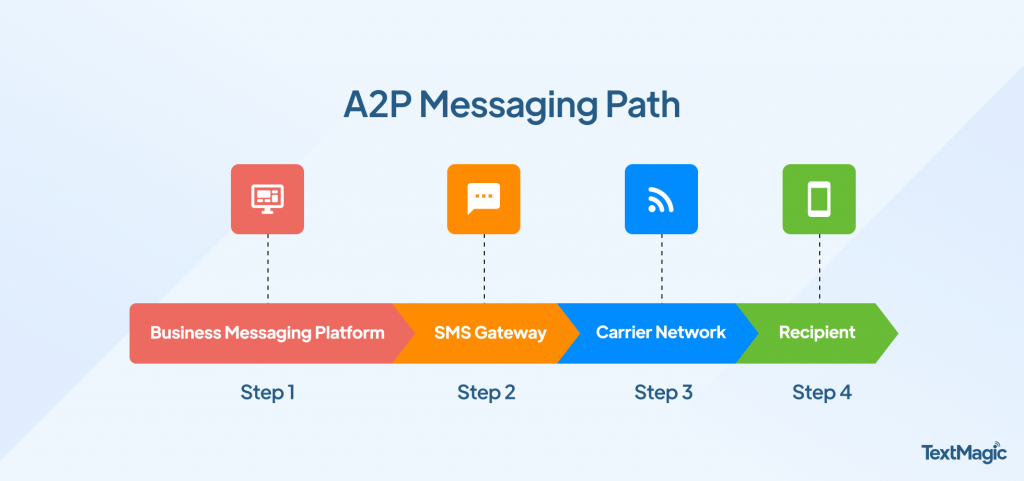Customers expect fast, clear updates from the brands they trust. They want messages that are timely and reliable. When someone makes a payment or signs in, they expect a response within seconds. Slow or missed messages can damage trust and hurt business results.
Manual communication can’t meet this demand anymore and growing businesses always need scale, speed and consistency in every interaction. A2P messaging solves this challenge. In this article, we’ll explain what A2P messaging is, how it works, and where it fits best.
We’ll cover its benefits, common use cases, channels and how Tech Alpha Group creates modern messaging. Let’s begin by understanding what A2P messaging actually means.
What is A2P Messaging?
Application-to-Person (A2P) messaging is the process of automatically sending SMS or MMS messages to specific customers from an application, usually utilised by enterprises. These messages are automated and often transactional or promotional. A2P messaging is used by banks, e-commerce platforms, healthcare providers, and many others.
Unlike P2P texting, A2P is not personal or manual. It is structured for high volume and reliability. It’s built to send thousands of messages at once and still deliver within seconds. Telecom rules govern this traffic to ensure safety and trust.
Every alert, confirmation, or offer you receive from a brand is likely A2P messaging. It keeps users informed and businesses connected.
Let’s look deeper at how this process works from start to finish.
How Does A2P Messaging Work?
A2P messaging starts with a system trigger. A user signs in, places an order or books an appointment. This action tells the backend software to send a message. The message request goes through a messaging platform like Tech Alpha’s A2P Messaging platform.

A snapshot of what an A2P Messaging platform looks like
The provider connects with telecom networks. It routes the message based on location, format, and rules. The mobile carrier then delivers it to the end user. This happens almost instantly.
Some messages allow replies. Others are one-way only. A2P platforms support both and offer tracking, reporting, and routing options.
Now that you understand how it works, let’s compare it with P2P messaging to see what makes A2P unique.
What is the Difference Between A2P vs P2P Messaging?
P2P stands for person-to-person messaging. It’s what we use daily with friends, family, and coworkers. These messages are sent manually and in small numbers. No business systems are involved.
A2P works differently. Here, the sender is an application. It messages many users automatically and follows strict rules. Businesses must register their messaging use and brand identity.
The key difference lies in scale, compliance, and automation. A2P is for structured business use while P2P is for everyday chats.
Want the full feature-by-feature breakdown? We have a detailed guide on A2P vs P2P messaging guide.
With that difference clear, let’s dive into the direct benefits of using A2P messaging.
Direct Benefits of A2P Messaging
Before diving into the technicals, it’s worth noting why so many businesses rely on A2P messaging in the first place. The advantages are not just theoretical—they’re practical, proven, and directly tied to performance metrics that matter. Here’s what sets A2P apart:
- Delivers instant, measurable communication benefits—messages are seen quickly, often within minutes.
- SMS open rates exceed 90%, making it ideal for alerts, password resets, and order updates.
- Highly scalable—businesses can send thousands of personalized messages via a single API call.
- A2P routes are trusted by telecom carriers, ensuring high delivery rates and minimal disruption.
- Reduces risk of messages being flagged or blocked—common with less formal messaging channels.
- Supports deep personalization using customer data like names, transactions, and appointment times.
- Increases relevance, drives higher customer response, and builds long-term engagement.
Beyond Basic Delivery: The Strategic Advantage of A2P
While A2P messaging offers clear benefits—speed, reliability, and reach—its strategic value extends deeply into a business’s operations and customer relationships. It’s not just about sending messages; it’s about optimizing the entire customer journey and internal workflows.
Consider the cost efficiencies. Automating routine communications like appointment confirmations or payment reminders significantly reduces the need for manual outreach. This frees staff for more complex customer service issues. Operational streamlining directly translates into reduced labor costs and improved resource allocation.
High deliverability and open rates for A2P messages also mean a much better return on investment compared to traditional marketing channels, where messages often go unread or undelivered.
A2P messaging builds strong customer relationships. Timely delivery of crucial information, whether a security alert or a shipping update it creates trust and transparency.
Customers feel valued and informed, leading to higher satisfaction and loyalty. This proactive communication can even prevent customer inquiries, reducing the load on support centers and enhancing the overall customer experience.
In a time of rising customer expectations, using A2P messaging is a norm for higher engagement, lesser churn and an ultimate sustainable business growth. It turns communication from a simple exchange into a powerful tool for strategic advantage.
Common Use Cases for A2P Messaging
A2P messaging powers many parts of business communication. From banking to e-commerce, it covers a wide range of needs.
Here are some of the most popular use cases:
1. Two-Factor Authentication and OTPs
Users get a one-time passcode to log in or approve payments. It keeps accounts secure and transactions safe.
2. Appointment Reminders
Clinics, salons, and service providers remind users of scheduled visits. This reduces no-shows and improves operations.
3. Transaction and Bank Alerts
Banks send real-time messages about account activity. These alerts include withdrawals, logins, or failed payments.
4. Marketing Campaigns and Promotions
Brands use A2P to send deals, sales alerts, and event invites. These messages are often personalized and time-sensitive.
5. Shipping and Delivery Notifications
Retailers keep buyers updated on their order status. This includes dispatch, delivery time, and receipt confirmations.
6. Customer Surveys and Feedback Requests
After service, businesses ask for quick feedback. This helps improve services and understand customer sentiment.
Each of these use cases shares one thing: they rely on speed, clarity and automation. That’s what A2P does best.
To make the most of these, businesses choose the right messaging channels. Let’s explore those next.
Some of the Channels of A2P Messaging
A2P messaging isn’t limited to SMS. Businesses now use several channels, each suited for different types of interactions.
- SMS is still the most common. It works on every mobile phone and doesn’t need the internet. It’s best for alerts, OTPs, and short updates.
- MMS supports images, videos, and audio. Retailers use it to send product shots or promotional graphics.
- RCS is a next-generation format. It offers buttons, brand logos, and interactive messages. It works inside the default messaging app on Android phones.
- Push Notifications come from apps. They’re useful for reminders, updates, or engagement when users are already active in your app.
- Voice Messages are also available. They’re used for accessibility, reminders, or in industries where users prefer spoken updates.
The right channel depends on your use case, customer habits, and message type. Many brands start with SMS, then expand as their needs grow.
About Tech Alpha Group
Tech Alpha Group builds communication systems that work in real time. We help businesses send messages that matter. Whether it’s a reminder, alert, or promotion, we deliver it with speed and accuracy..
TAG A2P Messaging
TAG A2P Messaging is built for high performance. It connects to carriers worldwide and handles millions of messages per day. Whether you send five or five million, it’s fast and secure.
It supports one-way and two-way flows. You can use it for
- Alerts
- Updates,
- Feedback
- 2FAs and more.
Our platform also offers message logs, delivery tracking and compliance tools.
You can connect TAG to your website, CRM, or app. Once set up, it runs quietly in the background. You focus on your business. We handle the messaging.
TAG Messaging gives you control, visibility, and peace of mind. It’s trusted by teams across industries for a reason.
Now it’s time to see what TAG can do for you.
Start Messaging Smarter
Every customer interaction matters. Make sure yours is fast, clear, and effective. With TAG A2P Messaging, your business stays connected, no matter the time or place.
We handle the complexity. You focus on growth. Book a free strategy call/demo with Tech Alpha Group today and take the next step.




